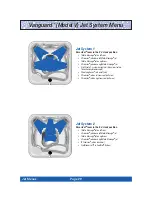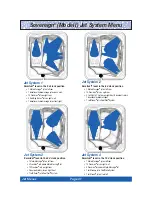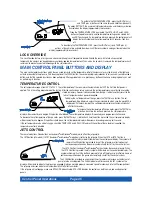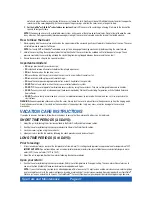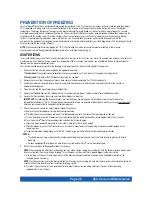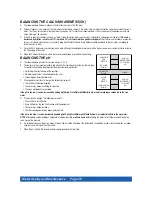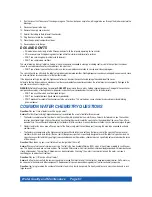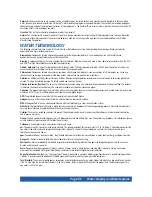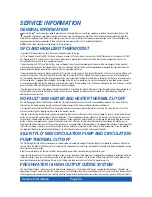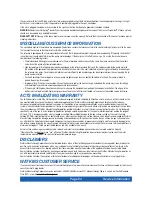
Page 43
Water Quality and Maintenance
c) Place the shop vac hose over the secondary “freeze” drain outlet and allow it to draw any remaining water from the spa’s bleedlines
(approximately 3 to 5 minutes).
9. Thoroughly dry the spa shell with a clean towel.
10. Leave the main drain valve open approximately 1/2 turn and leave the caps off of both outlets during the winter months.
11. Close the spa cover and fasten the cover tie downs. Cover the spa cover with a large piece of plywood to more evenly distribute the weight of
snow and ice.
WARNING: IF THESE INSTRUCTIONS ARE NOT FOLLOWED, DAMAGE DUE TO FREEZING WATER IN THE PLUMBING LINES MAY
OCCUR!
To Reactivate:
Reinstall the filter cartridges, close the main drain, and reinstall the drain caps. Follow the Start-Up and Refill Procedures to make your Hot Spring
®
spa operational.
IMPORTANT:
Always keep spa covered when not in use, whether it is empty or full.
WATER QUALITY AND MAINTENANCE
I
t’s important to have clean water. Water maintenance is one of the least understood, yet most important, areas of spa ownership. Your dealer
can guide you through the process of achieving and maintaining perfect water in your spa, given your local conditions. Your program will
depend on your water’s mineral content, how often you use your spa, and how many people use it. Here is our suggested step-by-step program:
Watkins Manufacturing Corporation has developed the EverFresh
®
water care system for its spas, which is an alternative to using an entirely
chlorine-based system. This system uses silver ions, ozone, and an oxidizer (monopersulfate, or MPS) and dichlor to sanitize the spa. It includes
the FreshStart
®
10,000
pre-filter, the FreshWater
®
III high output ozone system, and the FreshWater
Ag+®
silver ion purifier.
GENERAL INFORMATION
THE THREE FUNDAMENTAL AREAS OF WATER MAINTENANCE:
• Water Filtration
• Chemical Balance/pH Control
• Water Sanitation
Water sanitation is the responsibility of the spa owner, achieved through the regular and periodic (daily, if necessary) addition of an approved
sanitizer. The sanitizer will chemically control the bacteria and viruses present in the fill water or introduced during use of the spa. Bacteria and
viruses can grow quickly in undersanitized spa water.
The water’s chemical balance and pH control are also the responsibility of the spa owner. You will have to add chemicals to maintain proper levels
of Total Alkalinity (TA), Calcium Hardness (CH) and pH. Proper water balance and pH control will minimize scale buildup and corrosion of metals,
extend the life of the spa, and allow the sanitizer to work at maximum efficiency.
METHODS FOR TESTING THE SPA WATER
Accurate water testing and analysis are an important part of effectively maintaining your spa water. You must have the ability to test for:
• Total Alkalinity (TA)
• Calcium Hardness (CH)
• pH
• Sanitizer
Two types of testing methods are recognized and recommended by Watkins Manufacturing Corporation:
The Reagent Test Kit
is a method which provides a high level of accuracy. The reagents come in either liquid or tablet form.
Test Strips
are a convenient testing method used by many spa owners. Keep in mind that test strips are susceptible to heat and moisture
contamination, which will result in inaccurate readings.
IMPORTANT:
Always read and carefully follow the directions included with the Test Kit or Test Strips to ensure the accuracy of the test results.
BASIC CHEMICAL SAFETY
When using chemicals, read the labels carefully and follow directions precisely. Though chemicals protect you and your spa when used correctly,
they can be hazardous in concentrated form. Always observe the following guidelines:
• Allow only a responsible person to handle spa chemicals.
KEEP THEM OUT OF THE REACH OF CHILDREN.

